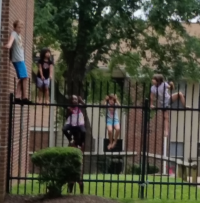This lucky homeowner has a new swimming pool just in time for the drought. What he doesn't have is any guidance from the contractor regarding the pool barrier.
That is always the case. Usually the owner calls for an inspection with no barrier whatsoever. The thinking is that the inspector will lead him to compliance.
In this case the owner placed a fence and gate across the driveway to the garage. The leaf that you see here is 52" wide and has an ornamental design that a kid could use to climb over the barrier. The contractor saw it before I did and advised the owner that it will not pass inspection because of the built in ladder. So the owner did this.

A single leaf can't be over 48" wide. A driveway can't be blocked. The contractor knows this and yet he lets the owners toss money away rather than help them. He didn't bother to tell the owner that it can't have a ladder built in.
By the time it gets to the fence and gate inspection, many owners are not on speaking terms with the contractor. And if they are still talking with the contractor, the contractor isn't talking to them about the required barrier. Not even a little bit....won't discuss it at all....acts like he has no clue as to what a pool barrier is....tells them to read their contract.
So I have to take over. I have to explain as many options as I can see...you know---put a fence here and a gate there, or you can put the fence over there, or you can put a fence around just the pool, etc.
It shouldn't be that way. I should ask them to tell me what they plan on doing and I will tell them if that's going to pass inspection. If I do that they are on the phone barking at the office manager that I am not willing to help. The manager tells me that it is my duty to be helpful.
Helpful is taking them by the hand and walking them through it. Later on I am likely to hear how they wish that the fence was somewhere else. It is my fault that they are not happy with "MY" choice.
The contractor should be held responsible for the fence and gate. It is on the plans and there is a place on the job card to sign off the fence and gate.
In the past I have contacted contractors and demanded that they deal with it. They always say that their contract specifies that the owner is responsible for the fence and gate. I am powerless to force contractors to be responsible.
The forum has contractors that build pools. I wonder what they do with the fence and gate.





